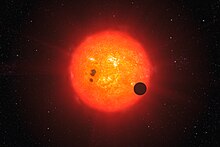GJ 1214
Gliese 1214 is a dim M4.5[4] red dwarf in the constellation Ophiuchus with an apparent magnitude of 14.7.[3] It is located at a distance of approximately 47 light years from Earth.[12] The star is about one-fifth the radius of the Sun[13] with a surface temperature estimated to be 3,110 K (2,840 °C; 5,140 °F).[9] Its luminosity is only 0.35% that of the Sun.[9]
The estimate for the stellar radius is 15% larger than predicted by theoretical models.[8] It also shows a 1% intrinsic variability in the near-infrared probably caused by stellar spots.[3] The star is rotating slowly, with a period that is most likely an integer multiple of 53 days. It is probably at least three billion years old and a member of the old thin disk of the Milky Way.[3] Although GJ 1214 has a low to moderate level of magnetic activity, it does undergo flares and is a source of X-ray emission with a base luminosity of 7.4×1025 erg s−1. The temperature of the stellar corona is estimated to be about 3.5×106 K.[11]
Planetary system
In mid-December 2009, a team of Harvard-Smithsonian astronomers announced the discovery of a companion extrasolar planet, Gliese 1214 b, potentially composed largely of water and having the mass and diameter of a super-Earth.[8][13]
| Companion (in order from star) |
Mass | Semimajor axis (AU) |
Orbital period (days) |
Eccentricity | Inclination | Radius |
|---|---|---|---|---|---|---|
| b | 8.17±0.43[14] M🜨 | 0.0143 ± 0.0019 | 1.58040456 ± 1.6x10−7[15] | <0.27 | 88.17° | 2.742+0.050 −0.053[14] R🜨 |

Discovered by the MEarth project and investigated further by the HARPS spectrograph on ESO’s 3.6-metre telescope at La Silla, GJ 1214 b is the second super-Earth exoplanet for which astronomers have determined the mass and radius, giving vital clues about its structure. It is also the first super-Earth around which an atmosphere has been found. A search for additional planets using transit timing variations was negative.[3]
No transit-time variations have yet been found for this transit. As of 2012, "the given data does not allow us to conclude that there is a [second] planet in the mass range 0.1–5 Earth-masses and the period range 0.76–1.23 or 1.91–3.18 days."[15] The X-ray flux from the host star is estimated to have stripped 2–5.6 ME from the planet over the lifetime of the system.[11]
In August 2022, this planetary system was included among 20 systems to be named by the third NameExoWorlds project.[16]
See also
References
- ^ Roman, Nancy G. (1987). "Identification of a Constellation From a Position". Publications of the Astronomical Society of the Pacific. 99 (617): 695–699. Bibcode:1987PASP...99..695R. doi:10.1086/132034. Vizier query form
- ^ a b c d e Brown, A. G. A.; et al. (Gaia collaboration) (August 2018). "Gaia Data Release 2: Summary of the contents and survey properties". Astronomy & Astrophysics. 616. A1. arXiv:1804.09365. Bibcode:2018A&A...616A...1G. doi:10.1051/0004-6361/201833051. Gaia DR2 record for this source at VizieR.
- ^ a b c d e f g h Berta, Zachory K.; et al. (2011). "The GJ1214 Super-Earth System: Stellar Variability, New Transits, and a Search for Additional Planets". The Astrophysical Journal. 736 (1). 12. arXiv:1012.0518. Bibcode:2011ApJ...736...12B. doi:10.1088/0004-637X/736/1/12. S2CID 118428858.
- ^ a b Rojas-Ayala, Bárbara; et al. (2010). "Metal-rich M-Dwarf Planet Hosts: Metallicities with K-band Spectra". The Astrophysical Journal Letters. 720 (1): L113–L118. arXiv:1007.4593. Bibcode:2010ApJ...720L.113R. doi:10.1088/2041-8205/720/1/L113. S2CID 118378322.
- ^ a b c "Gliese 1214". SIMBAD. Centre de données astronomiques de Strasbourg. Retrieved 2019-01-15.
- ^ a b c Skrutskie, Michael F.; Cutri, Roc M.; Stiening, Rae; Weinberg, Martin D.; Schneider, Stephen E.; Carpenter, John M.; Beichman, Charles A.; Capps, Richard W.; Chester, Thomas; Elias, Jonathan H.; Huchra, John P.; Liebert, James W.; Lonsdale, Carol J.; Monet, David G.; Price, Stephan; Seitzer, Patrick; Jarrett, Thomas H.; Kirkpatrick, J. Davy; Gizis, John E.; Howard, Elizabeth V.; Evans, Tracey E.; Fowler, John W.; Fullmer, Linda; Hurt, Robert L.; Light, Robert M.; Kopan, Eugene L.; Marsh, Kenneth A.; McCallon, Howard L.; Tam, Robert; Van Dyk, Schuyler D.; Wheelock, Sherry L. (1 February 2006). "The Two Micron All Sky Survey (2MASS)". The Astronomical Journal. 131: 1163–1183. doi:10.1086/498708. ISSN 0004-6256. Vizier catalog entry
- ^ van Altena, William F.; et al. The General Catalogue of Trigonometric Stellar Parallaxes. Yale University Observatory. ASIN B000UG5T6Y.Vizier catalog entry
- ^ a b c d e Charbonneau, David; et al. (2009). "A super-Earth transiting a nearby low-mass star". Nature. 462 (7275): 891–894. arXiv:0912.3229. Bibcode:2009Natur.462..891C. doi:10.1038/nature08679. PMID 20016595. S2CID 4360404.
- ^ a b c d e f g Pineda, J. Sebastian; Youngblood, Allison; France, Kevin (September 2021). "The M-dwarf Ultraviolet Spectroscopic Sample. I. Determining Stellar Parameters for Field Stars". The Astrophysical Journal. 918 (1): 23. arXiv:2106.07656. Bibcode:2021ApJ...918...40P. doi:10.3847/1538-4357/ac0aea. S2CID 235435757. 40.
{{cite journal}}: CS1 maint: unflagged free DOI (link) - ^ Mallonn, M.; et al. (2018). "GJ 1214: Rotation period, starspots, and uncertainty on the optical slope of the transmission spectrum". Astronomy and Astrophysics. 614. A35. arXiv:1803.05677. Bibcode:2018A&A...614A..35M. doi:10.1051/0004-6361/201732300. S2CID 73721250.
- ^ a b c Lalitha, S.; et al. (July 2014). "X-Ray Emission from the Super-Earth Host GJ 1214". The Astrophysical Journal Letters. 790 (1): 5. arXiv:1407.2741. Bibcode:2014ApJ...790L..11L. doi:10.1088/2041-8205/790/1/L11. S2CID 118774018. L11.
- ^ Anglada-Escudé, Guillem; Rojas-Ayala, Bárbara; Boss, Alan P.; Weinberger, Alycia J.; Lloyd, James P. (2012). "GJ 1214b revised. Improved trigonometric parallax, stellar parameters, orbital solution, and bulk properties for the super-Earth GJ 1214b". Astronomy & Astrophysics. 551: A48. arXiv:1210.8087v3. Bibcode:2013A&A...551A..48A. doi:10.1051/0004-6361/201219250. S2CID 55117987.
- ^ a b David A. Aguilar (2009-12-16). "Astronomers Find Super-Earth Using Amateur, Off-the-Shelf Technology". Harvard-Smithsonian Center for Astrophysics. Retrieved December 16, 2009.
- ^ a b Cloutier, Ryan; Charbonneau, David; Deming, Drake; Bonfils, Xavier; Astudillo-Defru, Nicola (2021), A More Precise Mass for GJ 1214 b and the Frequency of Multi-Planet Systems Around Mid-M Dwarfs, arXiv:2107.14732
- ^ a b Kennet B. W. Harpsøe; et al. (2012). "The Transiting System Gliese 1214". Astronomy & Astrophysics. 549: A10. arXiv:1207.3064. Bibcode:2013A&A...549A..10H. doi:10.1051/0004-6361/201219996. S2CID 53418632.
- ^ "List of ExoWorlds 2022". nameexoworlds.iau.org. IAU. 8 August 2022. Retrieved 27 August 2022.
External links

